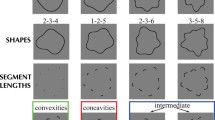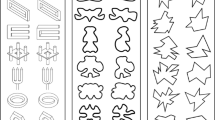The effectiveness of the discrimination of segment sizes by people with different cognitive style parameters – field dependence vs. field independence, analytical vs. synthetic, and flexible vs. rigid cognitive control – was studied. Discrimination effectiveness was assessed in terms of the magnitude of the Ponzo illusion. The magnitude of the Ponzo illusion was found to be significantly smaller in subjects with a field-independent cognitive style than in those with a field-dependent style. People with the flexible type of cognitive control demonstrated a tendency to more accurate perception of segment size in the Ponzo figure than those with rigid control. There was no relationship between the analytical-synthetic style of categorization and the magnitude of the Ponzo illusion.
Similar content being viewed by others
References
V. V. Kochetkov and I. G. Skotnikova, Individual Psychological Problems in Decision-Taking, Nauka, Moscow (1993).
I. G. Skotnikova, “Subjective psychophysics: study results,” Psikhol. Zh., 24, No. 2, 121–131 (2003).
M. A. Kholodnaya, Cognitive Styles. The Nature of the Individual Mind, Piter, St. Petersburg (2004).
A. I. Chakalina, “Experimental studies of the contribution of ‘fielddependent/field-independent’ cognitive style in the sensory performance of tasks with different levels of information load,” Vestn. Ekaterininsk. Inst., No. 4, 36–48 (2008).
A. I. Chekalina and A. N. Gusev, “Effects of flexibility/rigidity of cognitive control on the effectiveness of solving sensory tasks with different levels of information load,” Vestn. Gos. Obl. Univ. Ser. Psikhol. Nauki, No. 4, 3–10 (2008).
Yu. E. Shelepin, “The filtration properties of the receptive fields of visual cortex neurons,” Dokl. Akad. Nauk SSSR, 261, No. 6, 1506–1509 (1981).
Yu. E. Shelepin, “Local and global analysis in the visual system,” in: Contemporary Psychophysics,V. A. Barabanshchikov (ed.), Institute of Psychology, Russian Academy of Sciences (2009), pp. 312–337.
Yu. E. Shelepin, V. N. Chikhman, and N. Foreman, “Analysis of studies of the perception of fragmented images: overall perception and perception using local signs,” Fiziol. Zh., 94, No. 7, 758–776 (2008).
I. I. Shoshina, I. N. Perevozchikova, Yu. E. Shelepin, et al., “Characteristics of the perception of segment length in the Ponzo and Müller–Lyer illusions in schizophrenia,” Zh. Vyssh. Nerv. Deyat., 61, No. 6, 697–705 (2011).
I. I. Shoshina, S. V. Pronin, and Yu. E. Shelepin, “Effects of prior filtration of images on thresholds of segment length discrimination in the Müller–Lyer illusion,” Eksperim. Psikhol., 3, No. 4, 16–23 (2010).
C. Blakemore and F. Campbell, “On the existence of neurones in the human visual system selectively sensitive to the orientation and size of retinal images,” J. Physiol., 203, 237–260 (1969).
S. Bölte, M. Holtmann, F. Poustka, et al., “Gestalt perception and local-global processing in high-functioning autism,” J. Autism Dev. Disord., 37, No. 8, 1493–1504 (2007).
O. Braddick, J. M. D. O’Brien, J. Wattam-Bell, et al., “Form and motion coherence activate independent, but not dorsal/ventral segregated networks in the human brain,” Curr. Biol., 10, 731–734 (2000).
D. M. Broverman, “Cognitive style and intraindividual variation in abilities,” J. Personality, 28, 240–255 (1960).
F. Campbell and J. Robson, “Application of Fourier analysis to the visibility of gratings,” J. Physiol., 197, 551–556 (1968).
S. Coren and C. Porac, “Individual differences in visual-geometric illusions: Predictions from measures of spatial cognitive abilities,” Percept. Psychophys., 41, No. 3, 211–219 (1987).
R. W. Gardner, “Cognitive controls of attention deployment as determinants of visual illusions,” J. Abnorm. Soc. Psychol., 62, 120–127 (1961).
A. P. Ginsburg and D. W. Evans, “Predicting visual illusions form filtered images based on biological data,” J. Opt. Soc. Am., 69, 1443–1450 (1979).
E. J. Grinter, M. T. Maybery, P. L. Van Beek, et al., “Global visual processing and self-rated autistic-like traits,” J. Autism Dev. Disord., 39, No. 9, 1278–1290 (2009).
S. Kincade, Age, Sex, and Cognitive Style in the Ponzo Illusion, Univ. Publ., New Brunswick (1998).
E. Milne and M. Szczerbinski, “Global and local perceptual style, field-independence, and central coherence: An attempt at concept validation,” Adv. Cogn. Psychol., 5, 1–26 (2009).
R. E. Nisbett and Y. Miyamoto, “The influence of culture: holistic versus analytic perception,” Trends Cogn. Sci., 9, No. 10, 467–473 (2005).
A. W. Pressey, “Field dependence and susceptibility to the Poggendorff illusion,” Percept. Mot. Skills, 24, 309–310 (1967).
D. Ropar and P. Mitchell, “Susceptibility to illusions and performance on visuospatial tasks in individuals with autism,” J. Child. Dev. Psychiatry, 42, No. 4, 539–549 (2001).
D. Schiano and H. Zhang, “Cognitive styles: Illusory phenomena,” Percept. Mot. Skills, 60, 201–202 (1985).
D. Wagner, “Ontogeny of the Ponzo illusion: Effects of age, schooling, and environment,” Int. J. Psychol., 12, No. 3, 161–175 (1977).
E. Walter, P. Dassonville, and T. M. Bochsler, “A specific autistic trait that modulates visuospatial illusion susceptibility,” J. Autism Dev. Disord., 39, No. 2, 339–349 (2009).
T. Weckowitz and G. Witney, “The Müller–Lyer illusion in schizophrenic patients,” J. Ment. Sci., 106, 1002–1007 (1960).
H. A. Witkin, R. B. Dyke, H. F. Paterson, et al., Psychological Differentiation, Wiley, New York (1962).
C. Song, D. Schwarzkopf, and G. Rees, “Interocular induction of illusory size perception,” Neurosci. (2011), www.biomedcentral.com/1471-2202/12/27.
Author information
Authors and Affiliations
Corresponding author
Additional information
Translated from Zhurnal Vysshei Nervnoi Deyatel’nosti imeni I. P. Pavlova, Vol. 63, No. 3, pp. 349–356, May–June, 2013.
Rights and permissions
About this article
Cite this article
Shoshina, I.I., Shelepin, Y.E. Effectiveness of Discrimination of the Sizes of Line Segments by Humans with Different Cognitive Style Parameters. Neurosci Behav Physi 44, 748–753 (2014). https://doi.org/10.1007/s11055-014-9978-2
Received:
Accepted:
Published:
Issue Date:
DOI: https://doi.org/10.1007/s11055-014-9978-2




